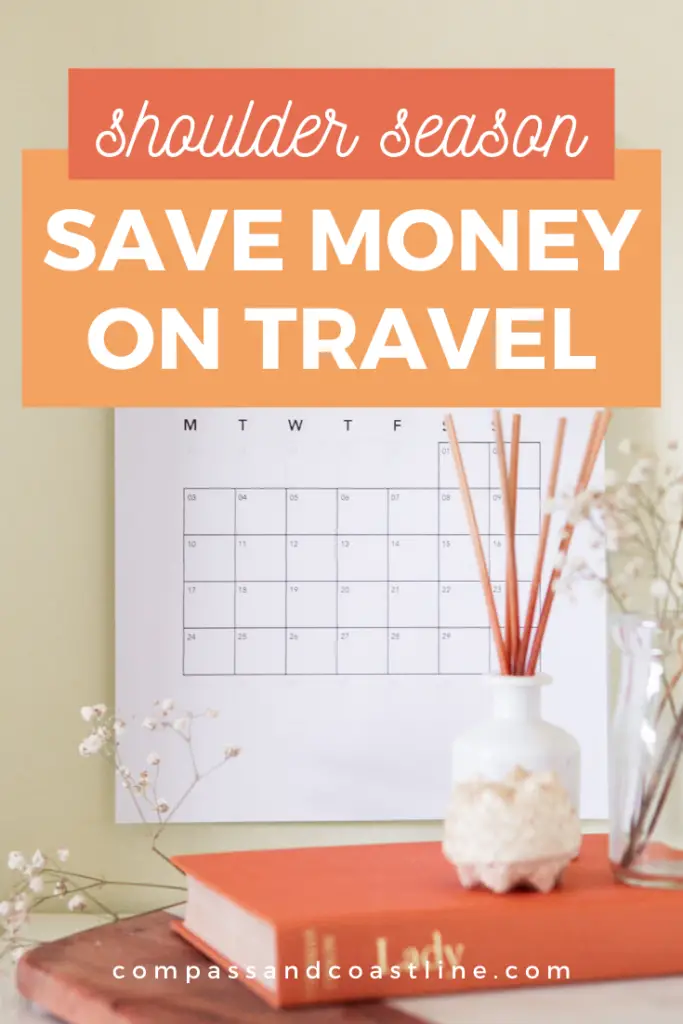Have you heard of shoulder season? It’s is one of the most underrated times to travel (yet one of the best ways to save money on a trip). In this post, we’ll talk about what shoulder season is all about, how it’s different from other travel times, and how to find travel deals. Think travel is expensive? It doesn’t have to be…

There are some things in life that we splurge on.
For me, it’s getting a fancy facial or skin treatment. I love going to the spa, getting pampered…
But even though I love doing it, I don’t do it often because it’s pricey. Can you relate?
Lots of people don’t travel even though they really want to because of the cost. But there’s a secret to affordable travel… and it’s called shoulder season!
What Is Shoulder Season?
If you thought traveling was out of reach, it isn’t! You don’t need to save for years, get a second job or take any drastic measures to travel affordably.
Traveling during shoulder season is a game-changer and helps you save substantially on your trip costs
You might be thinking what is shoulder season?
In any destination you visit, there’s a “high season” or “peak season” (aka the most popular time to travel) and “low season” or “off-peak season” (the least popular time to travel). Shoulder season is the period of time in between high and low season. It’s the sweet spot!
What’s So Great About It?
Here are a few things I love about this underrated travel period that we’ll discuss more down below:
- You can avoid big crowds
- It’s often during periods of nice weather
- there are good deals to be had!
Something important to know is that shoulder season is different for each destination. For example, in Puerto Vallarta, Mexico it’s April through early June while in Iceland it’s early May and October.
Once you have a destination in mind, figure out when their shoulder season is. Then consider weather conditions and activities you want to do. Once you have that information, you can then find a date that overlaps with your trip criteria!
Shoulder Season = Cheaper Prices
The simple fact is, fewer people travel during shoulder season.
A few reasons are that schools are in session and it’s not an ideal time for busy families. Many people choose to travel during peak season for convenience and good weather.
It often gets overlooked. Because of that, demand is lower and you can negotiate better prices on everything from flights to hotels and even tickets at attractions.

It’s true, shoulder season means lower prices across the board! Isn’t it awesome when you can learn how to travel cheap?
It’s a great opportunity to save significant money on your trip. Here’s one example of how you can travel more affordably if you take advantage of it…
Here’s An Example:
Say, for example, you want to plan a trip to Puerto Vallarta, Mexico. To demonstrate how much money you can save, let’s assume you want to travel sometime in the fall or winter and you’re departing from Dallas, Texas.
From a quick online search of Puerto Vallarta, Mexico, I found that their shoulder season is September/October and peak season is December and January. Using Google Flights, I found a round-trip flight for $214 from Dallas to Puerto Vallarta on September 18-24. See below:

Compare this to the same travel (Dallas to Puerto Vallarta) using different dates and you get significantly more expensive pricing. To travel on December 20-26, it costs almost $800!

This is just one example of how much money you can save by choosing to travel during shoulder season. You can imagine how it would really add up once you factor in flights, rental cars, hotels… Pretty cool, right?
Traveling during this timeframe can save tons of money.
Shoulder Season = Less Crowded
Another great benefit is that it’s way less crowded. Fewer people traveling means less congestion and a more enjoyable experience for you.
Popular tourist destinations can be unbearably crowded during peak times, so be strategic and avoid those times.

One of the best things to do in Rome is to see St. Peter’s Basilica. It’s a beautiful and iconic church, and one of the most famous in the world. On our trip to Rome, however, the line to get in was completely ridiculous. There must have been thousands of people in line and the line was barely inching forward.
Sadly, I didn’t end up going inside the Basilica. It was just too crowded and we would’ve been in line for hours. On my next trip to Rome, I’ll definitely be mindful and travel during off-peak times!
It can mean the difference between doing something awesome or missing out.
Shoulder Season = More Options
Speaking of doing awesome things while traveling… another benefit is all the options you have!
During peak season, tickets sell out fast, and time slots get booked in no time. But fewer visitors = fewer crowds = more availability!

That means you have the potential to do and see more on your trip. Many major attractions have to be booked extremely far in advance. But during shoulder season, you’ll have more flexibility and a better chance of grabbing tickets before they’re gone.
I’m currently planning a weekend in San Francisco, and my husband and I want to tour Alcatraz. After doing a little research, we discovered that tickets for the guided tour sell out FAST. Luckily, since we’re traveling there during the off-peak time of year, we were able to get tickets relatively easy. Woohoo! Shoulder season for the win!
It’s Seriously the Best
Why travel during the hottest, most crowded, and most expensive times? That sounds like a disaster to me.
There’s a better, smarter way! Shoulder season is the absolute best time to travel. If you can visit the same destination, pay less, have more options and deal with fewer crowds… why wouldn’t you?
Remember to do some research before booking your trip – each destination has a different shoulder season.
You might be surprised how affordable travel can be! Shoulder season is the most underrated time to travel (the secret’s not out yet!) so take advantage and go find a great travel deal. For more ideas on how to travel cheap, check out my post How To Travel Cheap for tons of great ideas to save money.
Before You Go…
To help you plan your trip, here are a few more resources I think you’ll like:
- Super Easy Ideas For Traveling With Pets
- Best Podcasts About Travel
- Travel Anxiety: 5 Strategies To Let Go Of Stress




